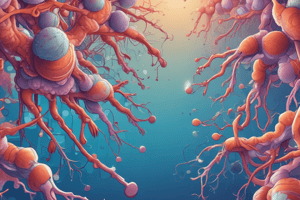Podcast
Questions and Answers
What is the purpose of polyethylene glycol (PEG) in monoclonal antibody production?
What is the purpose of polyethylene glycol (PEG) in monoclonal antibody production?
- To isolate splenocytes for further analysis
- To improve the specificity of the antibodies
- To fuse the membranes of myeloma and spleen cells (correct)
- To enhance the growth rate of myeloma cells
Which step involves validating and characterizing potentially high-producing hybridoma colonies?
Which step involves validating and characterizing potentially high-producing hybridoma colonies?
- Scale up and wean
- Functional characterization (correct)
- Clone screening/selection
- Preparation of myeloma cells
What is a key advantage of monoclonal antibodies (mAbs) compared to polyclonal antibodies (pAbs)?
What is a key advantage of monoclonal antibodies (mAbs) compared to polyclonal antibodies (pAbs)?
- Faster production time
- Lower cost of production
- Higher specificity to a single epitope (correct)
- Higher batch-to-batch variability
What is one limitation associated with monoclonal antibody production?
What is one limitation associated with monoclonal antibody production?
What is the projected annual growth rate (CAGR) for the monoclonal antibodies market from 2024 to 2033?
What is the projected annual growth rate (CAGR) for the monoclonal antibodies market from 2024 to 2033?
Why is batch-to-batch reproducibility important in monoclonal antibody production?
Why is batch-to-batch reproducibility important in monoclonal antibody production?
Which step follows the screening and selection of clones in monoclonal antibody production?
Which step follows the screening and selection of clones in monoclonal antibody production?
What was the estimated global market size for monoclonal antibodies in 2023?
What was the estimated global market size for monoclonal antibodies in 2023?
What does the suffix 'Omab' in monoclonal antibodies indicate?
What does the suffix 'Omab' in monoclonal antibodies indicate?
Which type of monoclonal antibody is fully composed of human proteins?
Which type of monoclonal antibody is fully composed of human proteins?
Which type of mAb is a combination of mouse and human proteins?
Which type of mAb is a combination of mouse and human proteins?
What is a key characteristic of naked monoclonal antibodies?
What is a key characteristic of naked monoclonal antibodies?
What is the process for producing monoclonal antibodies?
What is the process for producing monoclonal antibodies?
Bispecific monoclonal antibodies are designed to do what?
Bispecific monoclonal antibodies are designed to do what?
Which of the following is a therapeutic indication for Trastuzumab?
Which of the following is a therapeutic indication for Trastuzumab?
What defines a conjugated monoclonal antibody?
What defines a conjugated monoclonal antibody?
Flashcards
What are monoclonal antibodies (mAbs)?
What are monoclonal antibodies (mAbs)?
Monoclonal antibodies (mAbs) are produced by a single clone of B cells, resulting in a homogeneous antibody that targets a specific epitope on an antigen molecule.
What are Omabs?
What are Omabs?
mAbs derived from mouse proteins. They are often used to treat lymphoma and autoimmune diseases.
What are Ximabs?
What are Ximabs?
mAbs that are a combination of mouse and human proteins. These have improved properties compared to Omabs, such as reduced immunogenicity.
What are Zumabs?
What are Zumabs?
Signup and view all the flashcards
What are Umabs?
What are Umabs?
Signup and view all the flashcards
What are naked mAbs?
What are naked mAbs?
Signup and view all the flashcards
What are conjugated mAbs?
What are conjugated mAbs?
Signup and view all the flashcards
What are bispecific mAbs?
What are bispecific mAbs?
Signup and view all the flashcards
Monoclonal Antibody (mAb)
Monoclonal Antibody (mAb)
Signup and view all the flashcards
Myeloma Cells
Myeloma Cells
Signup and view all the flashcards
Hybridoma Technology
Hybridoma Technology
Signup and view all the flashcards
Clone Screening/Selection
Clone Screening/Selection
Signup and view all the flashcards
Hybridoma Expansion
Hybridoma Expansion
Signup and view all the flashcards
Polyclonal Antibody (PAb)
Polyclonal Antibody (PAb)
Signup and view all the flashcards
Monoclonal Antibody Diagnostics
Monoclonal Antibody Diagnostics
Signup and view all the flashcards
Monoclonal Antibody Therapeutics
Monoclonal Antibody Therapeutics
Signup and view all the flashcards
Study Notes
Introduction to Immunoanalysis
- Immunoanalysis is a field focusing on the detection and measurement of molecules using antibodies.
- Monoclonal antibodies (mAbs) are key tools in this field.
Learning Objectives
- Describe the characteristics of mAbs.
- Understand the meaning of mAb suffixes (omab, ximab, zamab, umab).
- Define naked mAbs, conjugated mAbs, and bispecific mAbs.
- Explain the process of mAb generation.
- Compare and contrast the use of mAbs and polyclonal antibodies (PAbs).
Monoclonal Antibodies (mAbs)
- mAbs are secreted by a single plasma cell clone.
- They are derived from a single B-lymphocyte precursor.
- They are produced by plasma B cells cultured in a lab.
- These specialized cell lines are known as hybridomas.
- Hybridomas secrete only one unique antibody type.
- mAbs are homogeneous, targeting a single epitope on an antigen molecule.
mAb Therapeutics - Suffixes of Relevance
- Omab (Murine): Derived from mouse proteins.
- Ximab (Chimeric): A combination of mouse and human proteins.
- Zumab (Humanized): Contains small portions of mouse proteins combined with human proteins.
- Umab (Human): Composed entirely of human proteins.
mAbs for Oncology
- mAb therapeutics are used to treat various cancers like lung cancer, brain tumors, ovarian cancer, breast cancer, gastric cancer, melanoma, colorectal cancer, Hodgkin's lymphoma and others.
- Naked mAbs: Used as standalone therapy.
- Conjugated mAbs: Modified with radioactive particles or drug compounds to enhance therapeutic impact.
- Bispecific mAbs: Designed to target two different antigens simultaneously, boosting immune cell activity against the tumor.
Monoclonal Antibody Production - Steps
- Step 1: Immunization and Isolation of Splenocytes: Immunizing animals (e.g. mice) to stimulate antibody production against a specific antigen, followed by blood collection and isolation of antibody-producing splenocytes.
- Step 2: Preparation of Myeloma Cells: Immortalization of myeloma cells for prolonged growth in the lab.
- Step 3: Fusion: Fusing the antibody-producing splenocytes with immortalized myeloma cells to create hybridomas.
- Step 4: Clone Screening/Selection: Screening resulting hybridomas for the desired antibody production based on antigen specificity.
- Step 5: Functional Characterization: Confirming and validating the characteristics of high-producing clones (e.g., ELISA).
- Step 6: Scale Up and Wean: Increasing the production scale and eliminating selection agents to create uniform antibody production.
- Step 7: Expansion: Scaling up antibody production using advanced systems like bioreactors.
Advantages of mAb Production
- Batch-to-batch reproducibility (high homogeneity).
- Large-scale production is possible.
- Low cross-reactivity, high specificity to a single epitope of the antigen.
- Increased sensitivity for quantifying protein levels.
- Low background noise.
Limitations of mAb Production
- High production cost.
- Requires significant time (6 months) for developing hybridized clones.
- Susceptibility to binding alteration when tagged/labeled.
Compare/Contrast MAbs and PAbs
- mAbs exhibit high specificity, compared to PAbs which recognize multiple epitopes.
- The creation of mAbs is more complex and more expensive, while PAbs are produced more readily but less specifically.
- mAbs offer higher reproducibility, whereas PAbs vary in the antibody population.
Global Market for mAb Production
- The monoclonal antibody market is predicted to exhibit robust growth.
- Significant global market size is forecast.
- Growth is expected across several medical areas.
Studying That Suits You
Use AI to generate personalized quizzes and flashcards to suit your learning preferences.
Related Documents
Description
Explore the fascinating field of immunoanalysis, focusing on the characteristics and applications of monoclonal antibodies (mAbs). This quiz covers the generation process of mAbs, their various types and suffixes, and how they compare to polyclonal antibodies. Test your knowledge and understanding of these critical tools in molecular detection.




